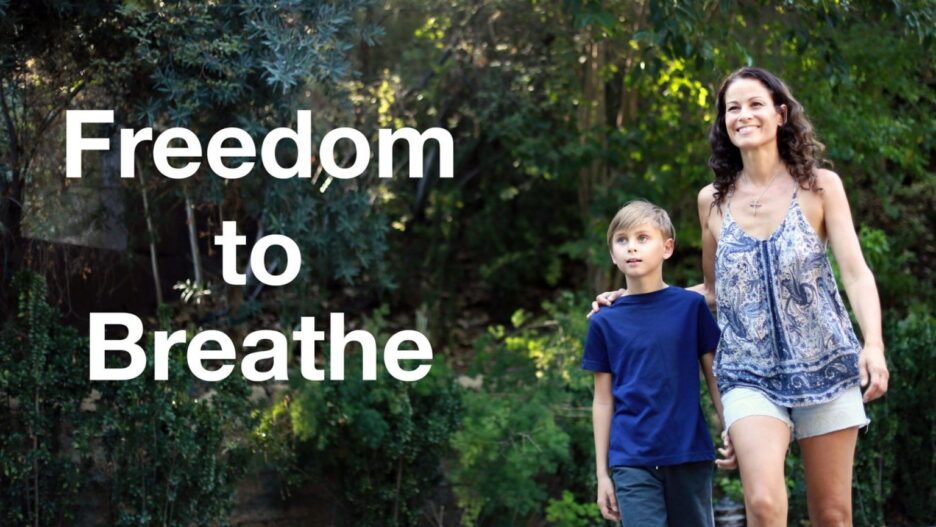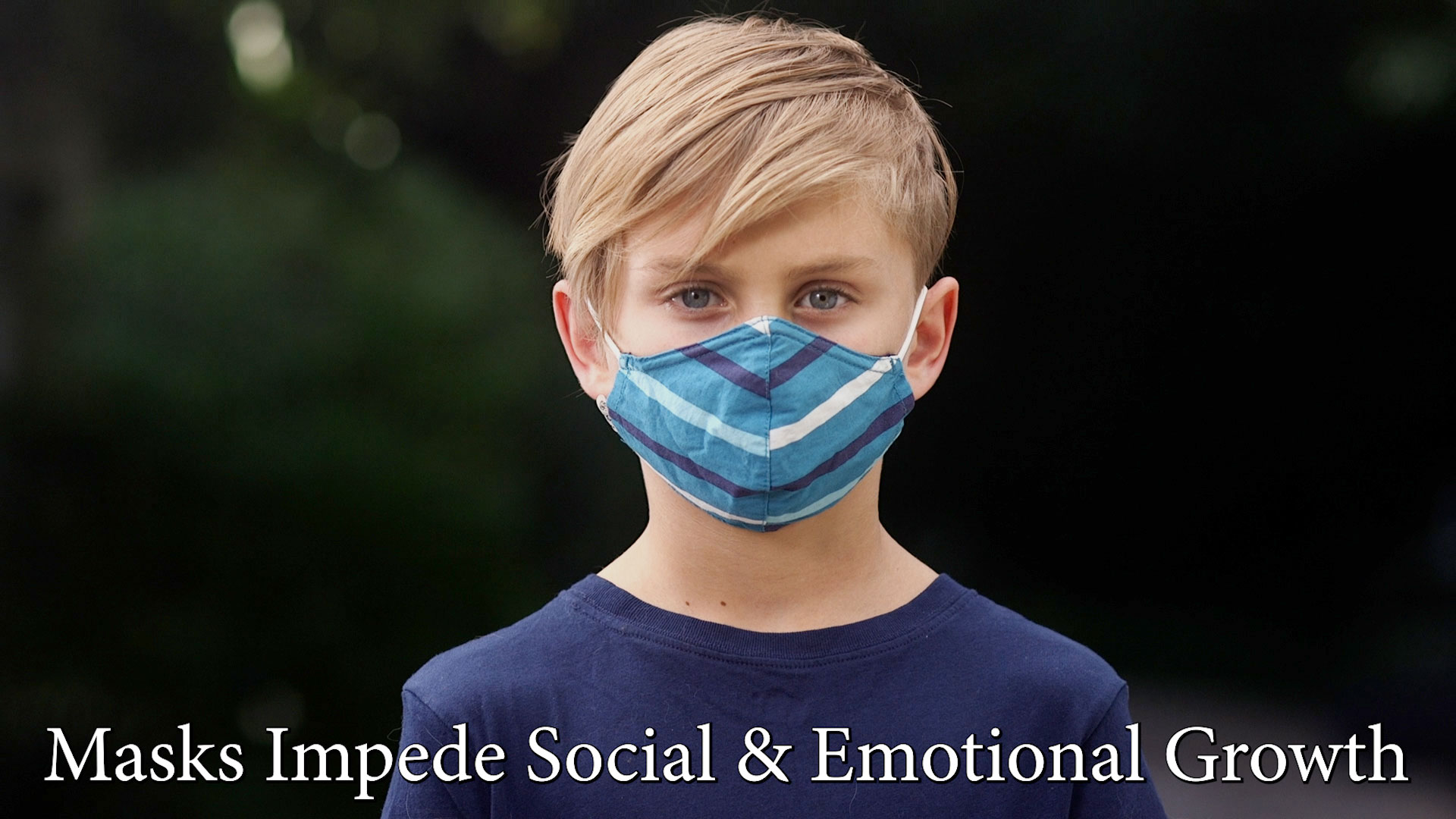Children Do Not Need To Be Masked!
“Does my child need to be masked outside, or even at all?”
by Nate Doromal
This is a question that many parents have wondered about during the course of the pandemic. And we are here to tell you that the answer is most definitely, NO. Read on to find out why.
The COVID pandemic has been difficult enough without adding on the additional burden of understanding the COVID science and rationales behind public health dictates. By default, Most of us choose to follow the crowd and obey the authorities without question.
Still, you might have an inkling inside of you, that question that wonders – am I doing the right thing for my child?
Here is where parental intuition can guide you. You might get the feeling that you aren’t being told the whole story, you might feel the need for more information so you can make better decisions, or you might wonder if dictates of public health are genuinely the best for your child.
As a parent, your first call of duty is to protect your child – not light your child on fire to keep other children warm. However, you should never entirely give up responsibility for your child to the experts.
In the following, here we will examine science around masks, and we will assert the case: the costs to masking a child outdoors far outweigh the benefits.
The Science Is Clear: Children Do Not Need To Be Masked
The authorities who claim your child needs to be masked in schools will do so primarily out of fear-based arguments that claim that 1) your child is in danger of COVID-19, or 2) your child is a threat to others around them. But, as we will see, both of these claims are false when looking at the nature of COVID-19.
COVID-19 Does Not Pose a Significant Risk to Children
The science says precisely – the vast majority of children deal with COVID-19 just fine. According to the UK data, the odds of a child dying from COVID-19 are akin to being struck by lighting.
UK Professor Robert Dingwall, a member of the New and Emerging Respiratory Virus Threats Advisory Group (NERVTAG), stated: “The risk of death in children is about one in five and a half million and they’re rather more likely to die in road accidents or even from lightning strikes than from the virus.”
The CDC corroborates such an assessment in its data: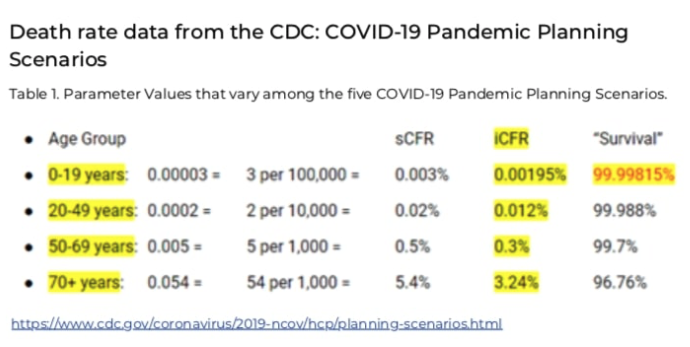
Moreover, science has already acknowledged children’s increased ability to fight off COVID-19. In a Nature article“How kids’ immune systems can evade COVID,” Columbia university immunologist Donna Farber stated, “Children are very much adapted to respond — and very well equipped to respond — to new viruses.”
Children’s immune systems mount an effective and quick response that essentially de-activates the COVID-19. As a result, when exposed to the SaRs-CoV-2 virus, the vast majority of children experience a mild case or do not exhibit any symptoms at all.
Children Are Not Significant Spreaders of COVID
To address the second claim that children are a threat to those around them, it appears that this claim is unsubstantiated when looking at the actual evidence.
A study of schools in Germany found that very few children had antibodies to COVID, which contradicted the notion that COVID was spreading via schools. In fact, Reinhard Berner from the University Hospital of Dresden said “Children may even act as a brake on infection.”
This finding was corroborated by the UK data. In a survey of more than 1 million children attending pre-school and primary school in the UK, only 70 children were affected by COVID. It is helpful to keep the absolute probabilities in mind – only 0.01% of these open educational settings had an outbreak.
The data is consistent – children are not a significant driver in spreading COVID. In a Huffington Post article “Why You Shouldn’t Worry About Kids Catching Covid In The Playground,” epidemiologist professor Sarah Lewis from the University of Bristol said “children are less likely to transmit the virus than adults.”
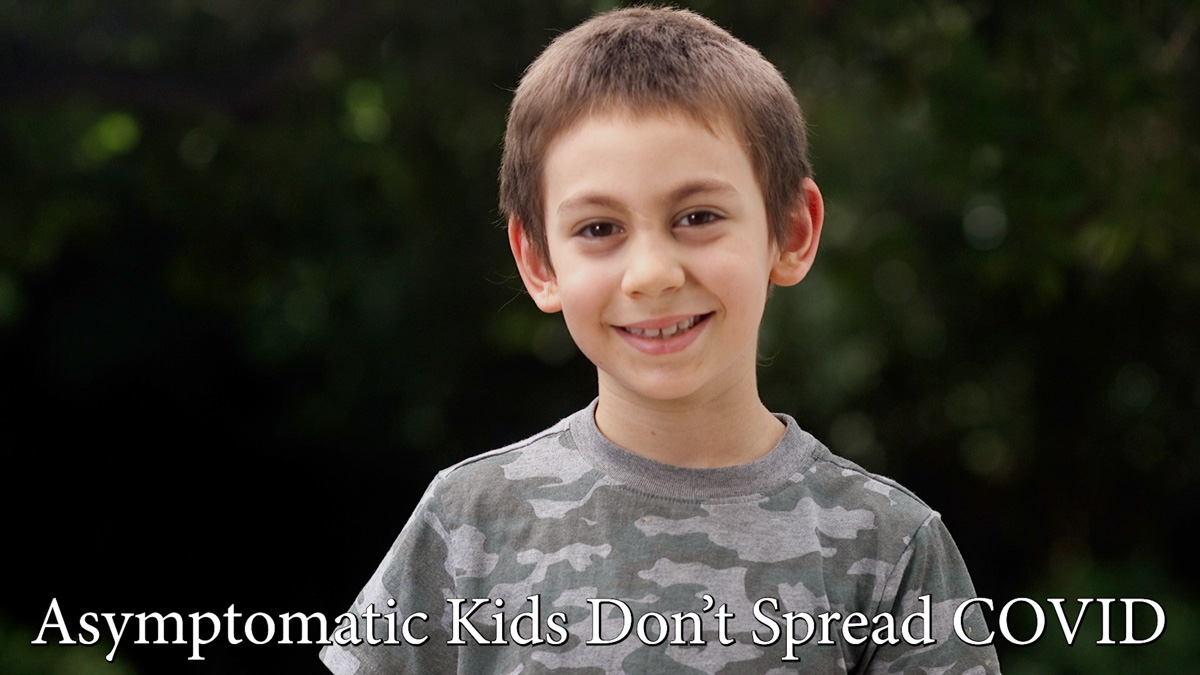
Should We Even Fear the Asymptomatic?
We were told by the media to “fear our neighbors” because of the potential of asymptomatic spread. But even the whole idea of the asymptomatic being drivers of COVID infection appears to be incorrect.
There is a big difference between the terms presymptomatic vs. asymptomatic. The former refer to people who go on to develop COVID symptoms, while the latter never do. As called out by journalist Jeremy Hammond, the NY Times and the CDC deliberately confuse these terms to overstate the danger level.
In June of last year, Dr. Maria Van Kerkhove, head of the WHO’s emerging diseases and zoonosis unit, reported that “From the data we have, it still seems to be rare that an asymptomatic person actually transmits onward to a secondary individual… It’s very rare.”
Suppose the WHO with its world-wide data collection schemes is having trouble finding asymptomatic transmission cases. Can’t we be a little less worried about healthy, unmasked people in our communities?
A recent study examined nearly 10 million residents in post-lockdown Wuhan and corroborated the WHO statement. It found that the rate of asymptomatic positive cases in the post-lockdown Wuhan was very low – akin to 1 in 30,000 – and there was no evidence that the identified asymptomatic positive cases were infectious.
There Are Early Treatments For COVID-19 – It’s Time We Used Them
Did you know that there are early treatments for COVID-19 that can markedly reduce the amount of severe COVID-19 cases and deaths? The group Front Line Critical COVID-19 Care has done fantastic work researching the drug Ivermectin in treating early COVID-19. The drug Ivermectin is an anti-parasitic medicine that has highly potent antiviral and anti-inflammatory properties against COVID-19.
They have found that Ivermectin has the following beneficial effects:
- It interferes with SARS-CoV-2 replication and binding to host tissue.
- It has potent anti-inflammatory properties that help mitigate the dangerous “cytokine storm.”
- It significantly diminishes viral load and protects against organ damage from SARS-CoV-2 or similar coronaviruses.
- It prevents the transmission and development of COVID-19 disease in those exposed to infected patients.
In a study by lead Argentinian investigator, Dr. Héctor Carvallo, not a single one of 788 healthcare workers given Ivermectin preventively got sick with COVID-19, while 58.2% of approximately 407 healthcare workers in the control group not taking Ivermectin (using only PPE) tested positive and got sick.
Other important early treatments are hydroxychloroquine (HCQ), which has extensive research behind it (here and here), and budesonide, which has been shown in a study to reduce severe COVID-19 by 91%.
Proper nutrition has a vital role in strengthening the immune system and helping the body fight off COVID-19. For example, vitamin D has been shown to reduce your risk of getting COVID-19 and its severity. Melatonin, Vitamin C, zinc, and quercetin have been shown to have similar effects.
Ivermectin, HCQ, and Budesonide can be obtained via prescription via telehealth consult with America’s Frontline Doctors.
Early treatments imply that we do not have to fear COVID-19 as much as we think. However, it also means the public health authorities are at fault for failing to investigate and make these protocols part of the standard COVID care protocols.
Furthermore, all of the above data should cause you to relax about masking yourself and your child. Your child isn’t at threat from COVID-19, and healthy children, like the kind running around on playgrounds, were never really spreaders of the virus anyway.
But you might wonder – isn’t wearing a mask as a precaution the rational thing to do? Should I mask myself and my child just in case? In the following section, we will examine precisely this.
The Science Is Clear: Masks are Ineffective
Mask mandates were touted as the panacea that would stop the pandemic. CDC Director, Dr. Robert Redford, claimed in July 2020 that “If all of us would put on a face-covering now for the next four weeks, six weeks, we could drive this epidemic to the ground.”
Did State-level Mask Mandates Make A Difference?
In the latter half of 2020, a string of states implemented mask mandates, and public health authorities began claiming victory when case rates started to drop. But, as we will see, this claim was premature when looking at the full data.
A problem to their approach, like in this Lyu/Wehby paper, only state-level case observational data was used to make the claim for mask efficacy, and it did so on a limited time period that failed to take into account the subsequent case increases seen in early winter. However, later research that looked at the longer time period, found no association between mask mandates and case decreases.
Let’s examine the data from New Jersey which showed an initial drop and then a subsequent climb in cases (graphs courtesy of rationalground.com):
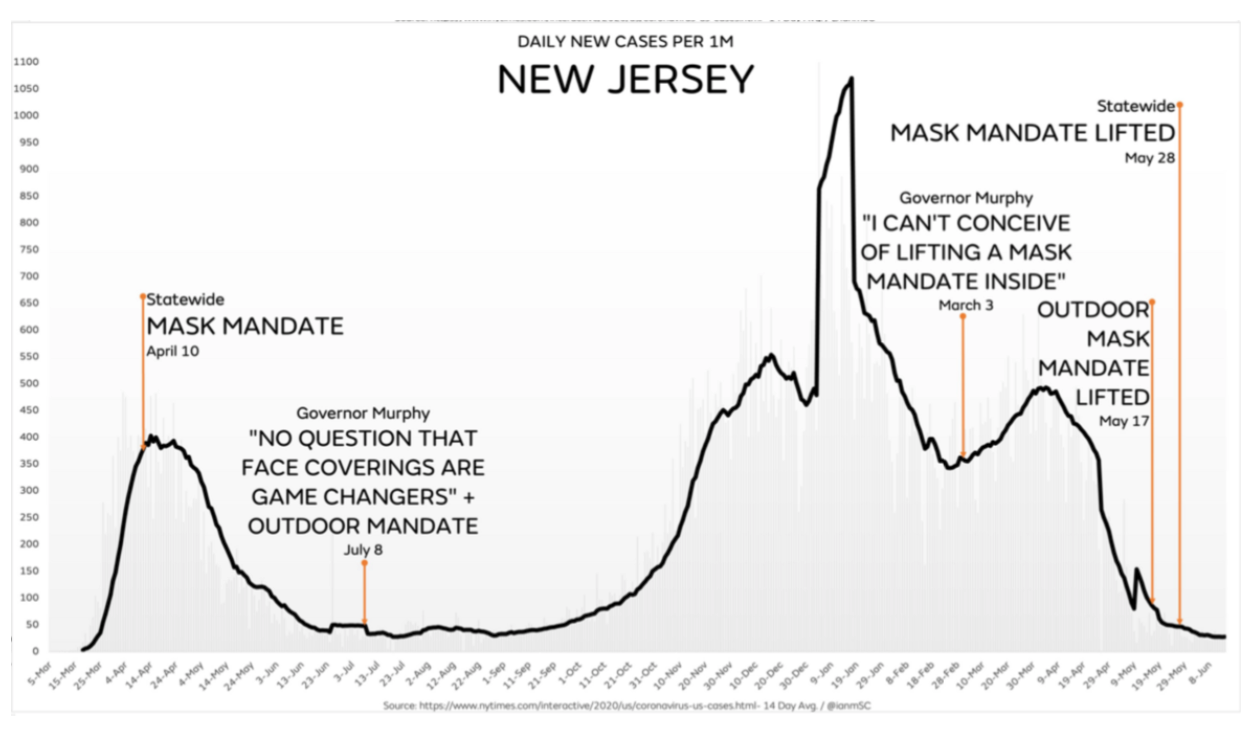
Next, let’s examine the data from Massachusetts:
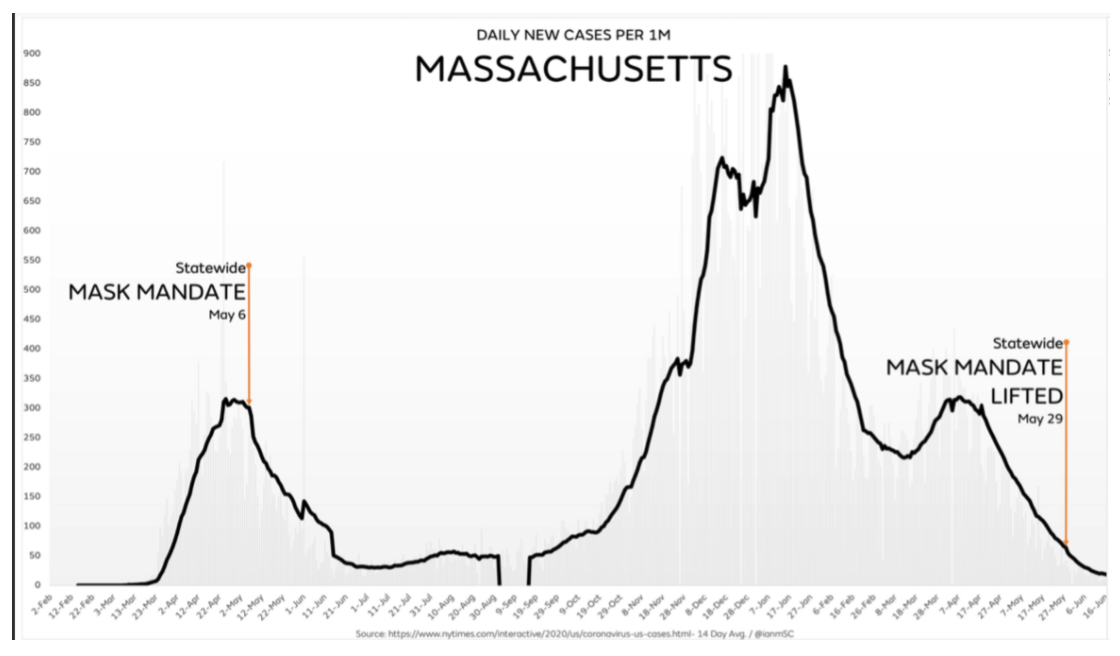
How about the data from California:
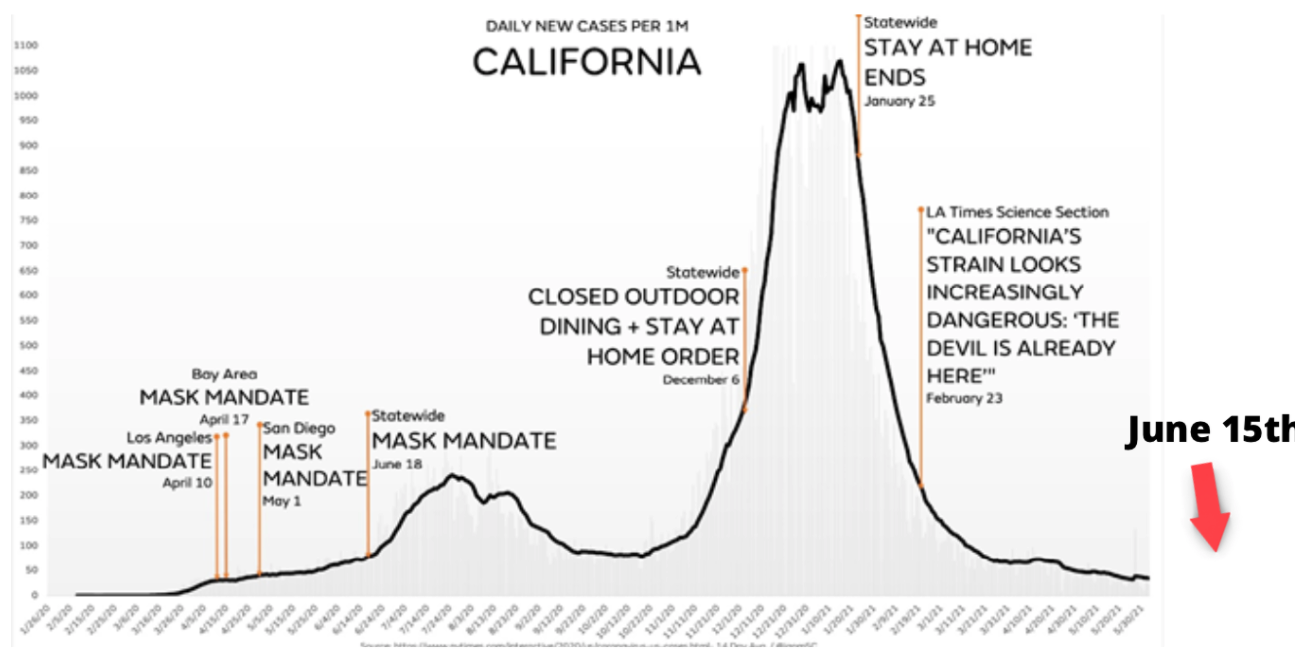
Florida never had a full mask mandate, and the pandemic trends look similar. Interestingly enough, the absolute peaks for Florida do not approach the levels of the highly masked states above.
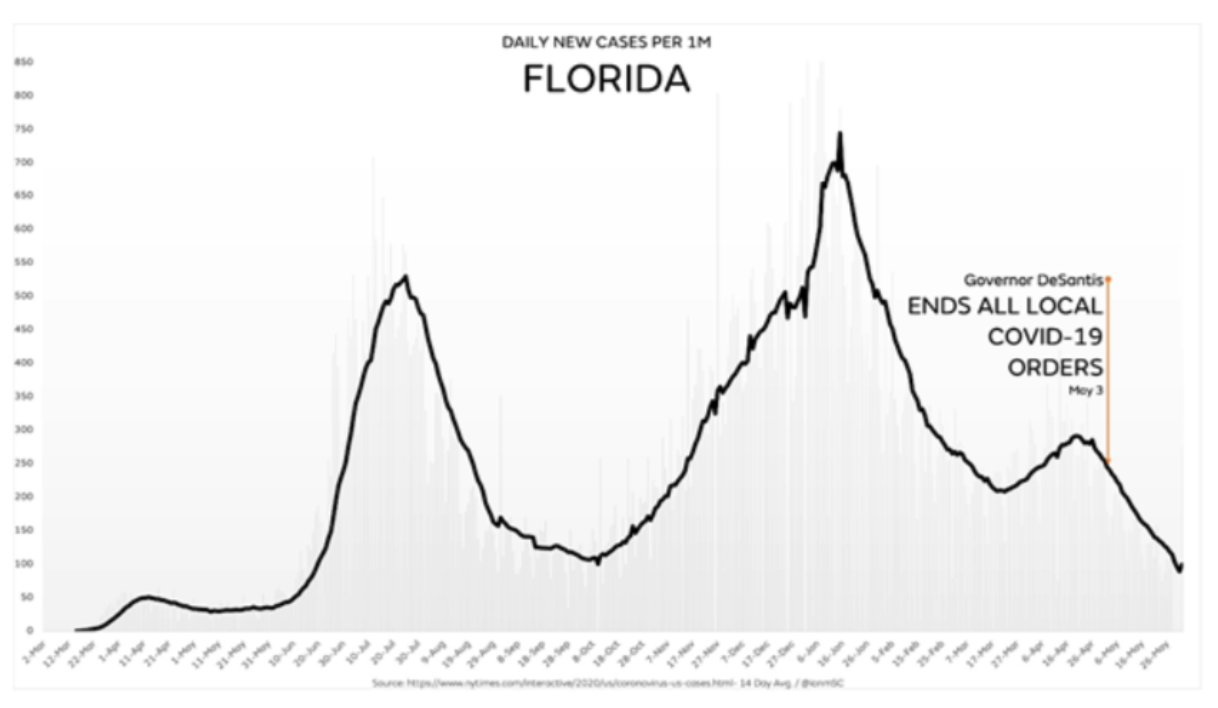
Despite public health’s and politicians’ touting of the importance of mask mandates, their use appeared to have made little difference in stopping the trend of the pandemic cycle.
What the Medical Literature Says: “Masks Aren’t Effective.”
The finding that “masks are ineffective” has been discussed in the medical literature before the pandemic and corroborated by medical studies during the pandemic.
When trying to validate medical science, the gold standard is the randomized-controlled trial (RCT) in which participants are randomly assigned to either the treatment group (which receives the treatment) or the control group (which does not receive the treatment). This random assignment allows researchers to control for confounding factors that could bias the results.
People are seldom aware of how much medical literature there is that shows that masks don’t make a difference:
- A large meta-review published by the CDC failed to find a significant effect of masks on influenza cases: “Although mechanistic studies support the potential effect of hand hygiene or face masks, evidence from 14 randomized controlled trials of these measures did not support a substantial effect on the transmission of laboratory-confirmed influenza.”
- The use of surgical face masks failed to reduce the incidence of the common cold in a randomized controlled trial of healthcare workers.
- A 2020 Cochrane review failed to show that face masks made a difference in the spread of influenza: “We are uncertain whether wearing masks or N95/P2 respirators helps to slow the spread of respiratory viruses.”
- A 2015 randomized controlled trial comparing cloth masks versus medical masks among healthcare workers found increased virus incidence in those wearing cloth masks: “ laboratory-confirmed viruses were significantly higher in the cloth masks group compared with the medical masks group. Penetration of cloth masks by particles was almost 97% and medical masks 44%.”
- A 2020 randomized controlled trial done in Norway, the largest done to date, on mask usage in the community failed to find that mask usage significantly decreased the incidence of COVID-19.
It is easy for people, even scientists and researchers, to become fixated on their expectations on how they believe the world works and to fail to update their beliefs in spite of contradictory evidence.
This is why gold-standard RCTs are needed to validate whether medical standards of care stand up to the test of scientific rigor. And the record is clear – there are no RCTs that show masks effectively control the spread of infection.
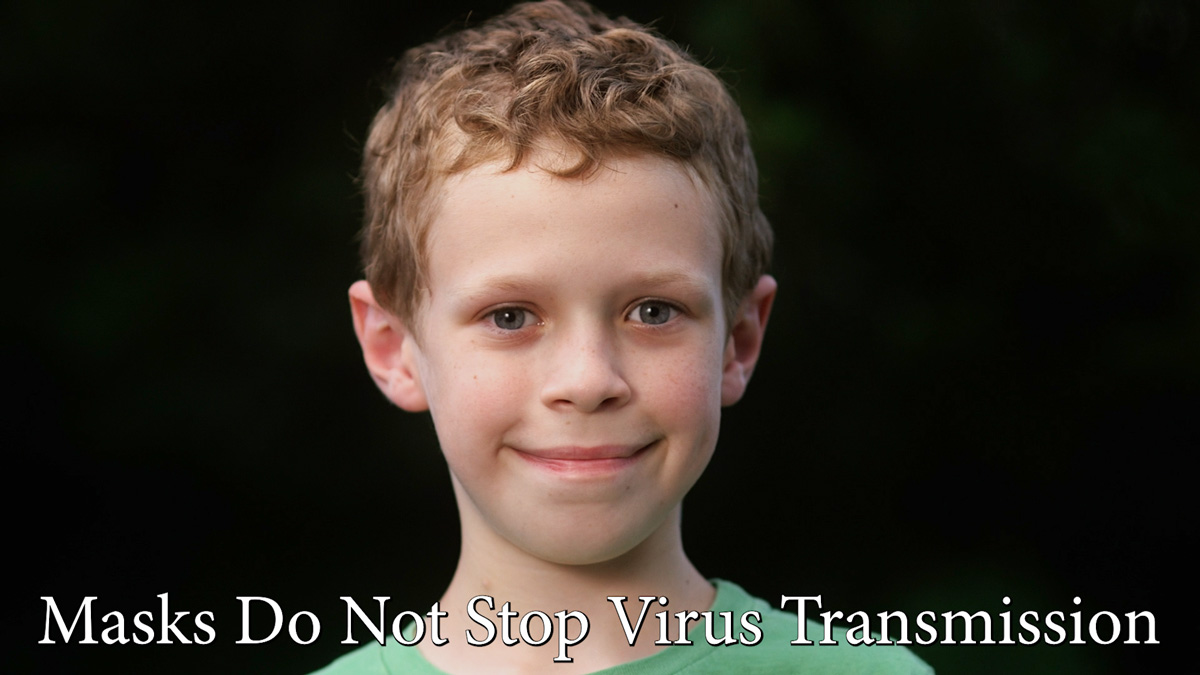
Even Dr. Fauci Knows Masks Aren’t Effective
Even one of the most prominent proponents for masking, Dr. Fauci, while advocating for masks publicly, privately acknowledges that masks are ineffective.
Dr. Fauci expressed these sentiments in his work emails which were disclosed under a Freedom of Information Act request:

Common sense may tell us that masking should stop droplets from spreading and thereby keep us safe. But with so much science contradicting the simple view, we should ask the question, “what exactly is going on here?”
Why Don’t Masks Work?
There’s a significant basic fact that mask proponents overlook – virus particles are too small to be filtered out by masks.
Masks Pores Are Too Small To Filter Out Aerosolized Viruses
The media likes to oversimplify explanations for the masses. For example, while masks can catch large droplets, like a mosquito going through a chain-link fence, smaller aerosolized materials will get through the pores of the mask. When viewed from this angle, it starts to make sense what the problem with masks is.
Let’s break it down. Cloth masks have pores that have a width of 80-500 microns. N95 masks, which are arguably more effective but more challenging to breathe in, have pores that are 0.3-10 microns in width. In contrast, the coronavirus is only 0.1 micron in size. It doesn’t take a genius to see the obvious – it will get through the pores.
It’s so obvious, in fact, that Dr. Fauci said it in the email above: “The typical mask you buy in the drug store is not really effective at keeping out the virus, which is small enough to pass through the material. It might, however, provide some slight benefit to keep out gross droplets if someone coughs or sneezes on you.”
Mask proponents latch onto the focus on large droplets while discounting the more dominant effect of the former. Large droplets naturally evaporate and aerosolize in the air. This is a basic scientific fact.
Kimberly Prather, professor of atmospheric chemistry at UC San Diego, explained in an interview with KRCW: “When you just speak, and especially if you’re someone that’s infected and doesn’t know it, you produce these … much tinier invisible droplets that basically can float in the air and travel much further than six feet, and can be inhaled. And that is not being really addressed by the WHO at this time.”
A Lancet article corroborated these findings: “Studies of cough aerosols and of exhaled breath from patients with various respiratory infections have shown striking similarities in aerosol size distributions, with a predominance of pathogens in small particles (<5 μm)… There is no evidence that some pathogens are carried only in large droplets.”
Next time you leave your house and see someone wearing a mask, note that the vast majority of people are wearing cloth masks, whose 80-500 micron pores do not provide adequate protection. Yet, these people have such faith in their masks. The world will look a little bit different with this knowledge.
Masks Can Assist In Spreading Infectious Disease
It’s a simple fact that when you exhale while wearing a mask that some of that moisture will get caught by the mask. You can feel this moisture yourself after using a mask. What isn’t commonly thought about is that the mask itself will accumulate viral and bacterial particles. Then, the act of touching or adjusting the mask, even putting it on or off, can move these viral and bacterial particles to your hand and to surfaces.
Recall the 2015 RCT study, which found that the cloth mask group actually experienced higher levels of infection relative to the control. The study authors conclude: “This study is the first RCT of cloth masks, and the results caution against the use of cloth masks. This is an important finding to inform occupational health and safety. Moisture retention, reuse of cloth masks and poor filtration may result in increased risk of infection.”
These findings were corroborated by a 2018 study that found that significant amounts of bacterial material accumulated on masks after two hours of usage. The study recommended that surgeons change their mask after every operation, especially after wearing them for more than two hours.
It is highly doubtful that the average person is adhering to the protocol of changing their mask every two hours and properly cleaning their masks after daily use. Healthcare workers are trained in proper mask usage while the public is not.
Can Wearing Masks Cause Harm?
The mask wearers often justify the lack of mask effectiveness by saying, “Sure, the mask isn’t fully effective, but what’s the harm in wearing one anyway?” Mask proponents and the media like to portray mask wearing as harmless, but is this really the case?
Our human body was wonderfully designed to fulfill certain operations, and one of those operations is breathing. We bring fresh air into the body via inhalation, and then we exhale the materials we do not need from the body.
Anything that interferes with this natural process can make this operation inefficient and cause unforeseen problems. For instance, sleep apnea can lead to an increased risk of high blood pressure, heart attacks, type 2 diabetes, and liver problems.What unforeseen problems come from prolonged mask wearing?
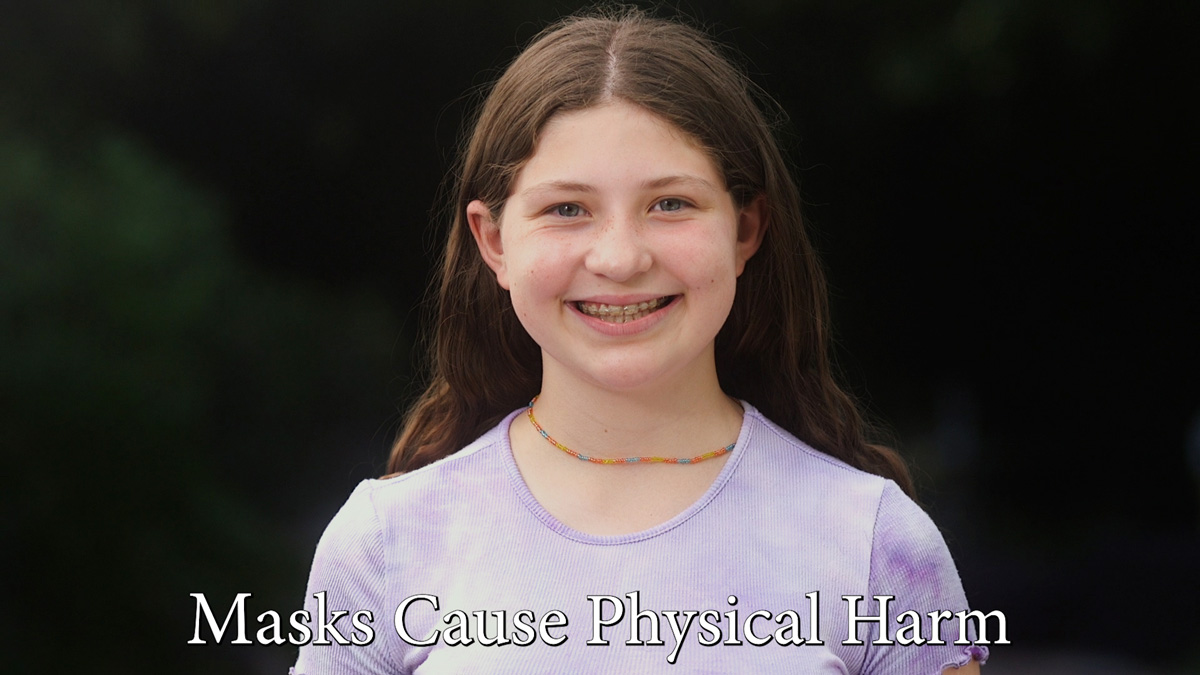
Masks Can Diminish Your Oxygen Levels
Anyone that has worn a mask can tell you that masks make breathing more difficult. Generally, the better the filtration, such as with an N95 mask, the harder it is to breathe. This interference with normal breathing can adversely affect your body’s oxygen levels.
What happens when we wear masks that restrict our breathing airflow? You end up rebreathing the air you exhale. Intuitively, your body wants to exhale its waste products, such as carbon dioxide and even virus/bacterial particles. It doesn’t take a genius to conclude that rebreathing your own exhalation sounds like a bad idea.
Scientist Dr. Judy Mikovits explained this nicely in her book The Case Against Masks: “Human beings need to breathe oxygen and exhale carbon dioxide. Oxygen is 20.9 percent of the air we breathe in, but only 16 percent of what we breathe out. OSHA regulations state that any oxygen-level below 19.5 percent is dangerous. Carbon dioxide is only at 0.04 percent in the atmosphere, but 4 percent of the air we breathe out, a hundred-fold increase. Carbon dioxide toxicity begins when those levels are around 10 percent. Masks lower oxygen levels and raise carbon dioxide levels.”
This concern with masks and rebreathing was explained by Dr. Margarite Griesz-Brisson MD, PhD, one of Europe’s leading neurologists, in an interview with AIER: “The rebreathing of our exhaled air will without a doubt create oxygen deficiency and a flooding of carbon dioxide. We know that the human brain is very sensitive to oxygen deprivation.”
The medical literature corroborates the above claims. A 2008 study examined surgeons wearing masks during operations and found that oxygen levels in the blood were decreased after 60 minutes, an effect that may affect their mental cognition.
Your brain uses 25% of the oxygen your body takes in. Diminished oxygen levels can impair brain function. As the Lung Health Institute explains: “Oxygen levels and brain function go hand-in-hand. When your brain has enough oxygen, your body functions better, and you’ll feel better. As your blood oxygen levels improve, you might notice improved cognitive function, better balance, and an overall improvement to your health.”
The effects of mask wearing while exercising can be dangerous. In China, news outlets reported two boys who diedwhile running during gym class with a N95 mask. In Oregon, a high school girl passed out while running a track racewearing a mask, an incident which led to state revisions of outdoor masking for athletic events.
But even without exercise, oxygen levels can still drop during various activities, such as this video in which a woman nearly passes out while, ironically, arguing for mask mandates.
Can you imagine your child in school wearing a mask all day long while attempting to learn while having a lower concentration of oxygen in the body? Can you imagine being a child and forced to wear a mask while in physical education class? Just what are we doing?
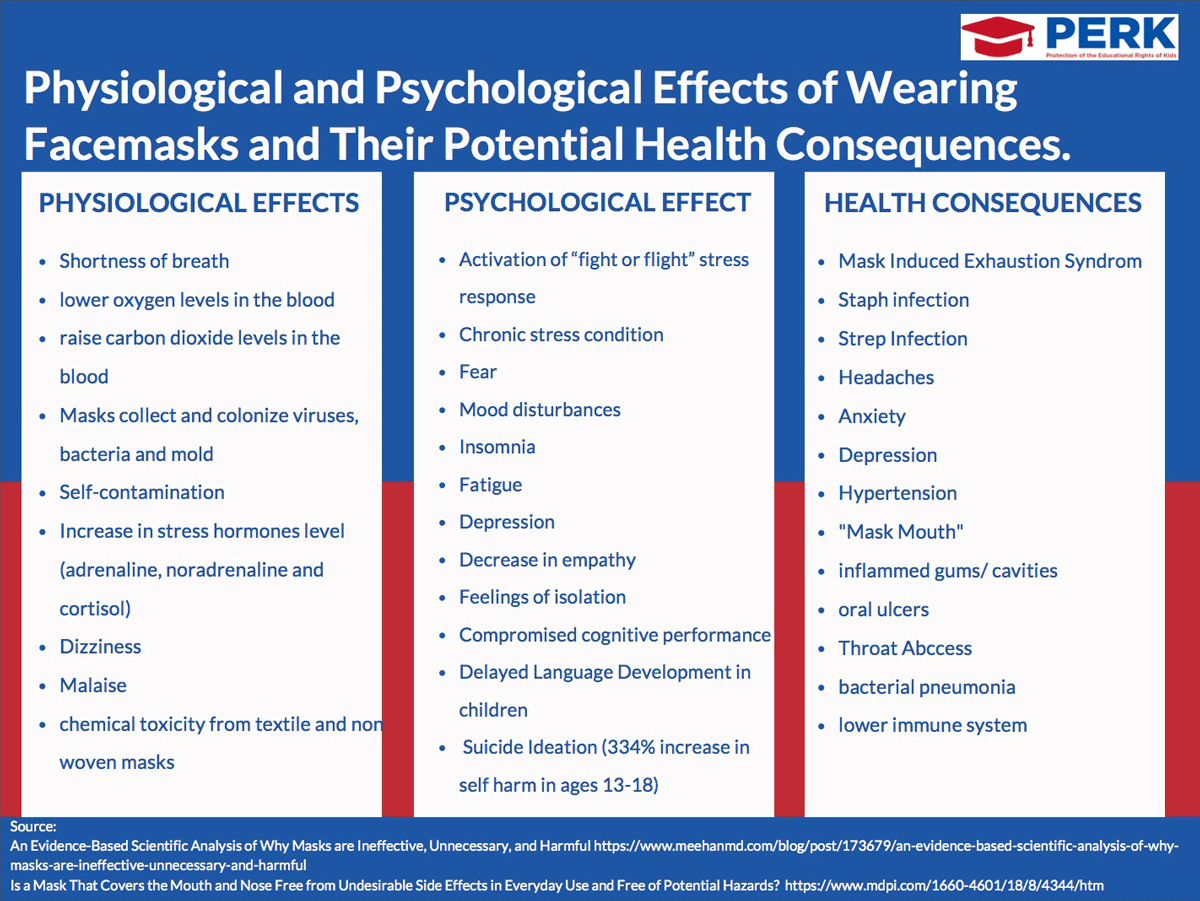
Masks Can Increase Your Risk From Infections
As we discussed previously, it is ironic that masks can increase the chances of infection by concentrating the viral and bacterial material in different places. While outdoors, the wind will naturally disperse any aerosolized pathogens, but instead, the exhaled pathogens can concentrate on the masks or on places on the face.
Dr. Judy Mikovits explains the problems with this succinctly: “By virtue of the mask being over a person’s face for the entire day, the mask itself has become a highly contaminated surface, especially on the inside portion of the mask. A simple reach inside the mask, perhaps to scratch an itch on the cheek or nose, now makes it likely that the person’s finger is loaded with viruses. A wipe of the eyes means the virus has been transferred to the watery surface of the eye, where it now has a clear path to the brain.”
Dr. Jim Meehan, in his book Why Wearing a Mask Makes Healthy People Sick, warns that masks worn improperly areworse than ineffective and that most people are using the masks wrong: “Take a trip to Walmart or your local school and observe how mask wearers pull masks from their pocket or purse, drop the masks on the floor, cough and sneeze in them, move them below the nose, on their heads, or under their chin. I see it every day. I also see their soiled and stained surgical face masks and know that these people are dangerously reusing a mask that should never be reused.”
A Rational Ground article, “Masks Are Not Source Control” reported that a mask that was lab-tested just after one day of use found numerous bacterial proteins on them, including bacterial proteins associated with pathogenic pneumonia, strep throat, tuberculosis, meningitis, and sepsis.
Imagine being a child in a school who is forced to wear a mask for eight hours a day. Do you think you might fiddle with your mask because it is uncomfortable? Do you think you might touch other surfaces or other students afterward?
Masks Can Interfere with Children’s Psychological Development
In the drive to win the pandemic war, authorities forget about the effect of mask mandates on children’s emotional development and psychological well-being.
Psychology research has shown that children look at faces in order to learn how to read the emotional content of a message, which can often contain the majority of the message’s meaning.
Thus, In blocking facial expressions, the extended use of mask-wearing schools and in the community can hinder the development of this psychological facility in children and can impede the normal development of a child’s emotional intelligence.
Dr. Kang Lee, a psychologist at the University of Toronto, commented on the facial recognition development in children: “The development of facial recognition is relatively weak in young children… It is not until kids are about 14 years old that they reach adult skill levels in recognizing faces. By putting on masks, we take away information that makes it especially difficult for children to recognize others and read emotional signals, which is unsettling and disconcerting. These issues may be especially true for children with autism spectrum disorder, including Asperger’s syndrome, who tend to have particular difficulties reading non-verbal cues.”
Even we adults need to see facial expressions to communicate and bond with each other fully. Kathleen M. Pike, PhD is Professor of Psychology, explains: “We depend on facial expressions to know and understand each other. With physical distancing, increased anxiety, and disrupted routines due to COVID19, we are primed to seek emotional connection by simply seeing each other’s facial expressions.”Children have a tremendous need for emotional connection and bonding. Yet, despite the low risk of COVID-19 death to children, they have been subjected to lockdowns that isolated them from peers and now masking that interferes with their emotional development. Is it any wonder that we have more “COVID Suicide” deaths in children than from COVID itself?
More Adverse Effects from Mask Usage
There are more physiological effects that should be noted from mask-wearing:
- Healthcare workers who wear masks for long periods have commonly reported headaches.
- A New York Post article reports on incidents of “mask mouth” in which chronic mask wearers have reported increased mouth inflammation, decaying teeth, receding gum lines and seriously sour breath.
- Skin infections from mask-wearing have been commonly reported, with some reports of fungal infection.
All of the above data shows you that wearing a mask is not risk-free but can be a source of risk itself. Mask wearing can possibly increase your risk from COVID-19, both increasing potential for incidence for you and those around, and then, due to the effects of decreased oxygen levels, compromises your body’s immune system’s ability to fight the infection.
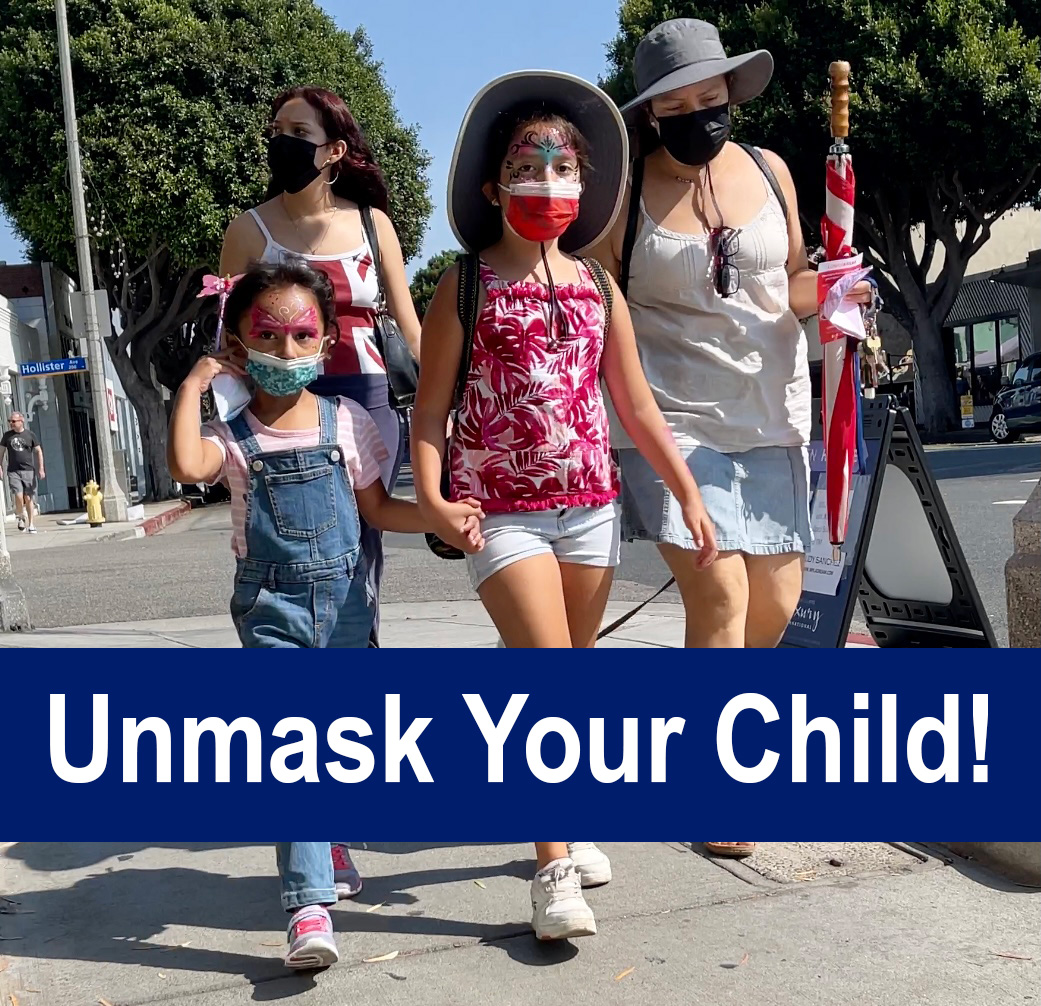
Parents: It’s Time To Stop Masking Now!
It should be clear from the above that there is a problem with the one-sided message from the media and politicians about masking. They present a simple panacea that sounds good but ignores the messy details that happen in the real world.
The cost/benefits calculation is not so simple and innocents can be harmed. Thus, it is essential that – individuals and parents are given the right to decide what to do.
Now, we all live in different states with different mandates but there is one thing we can all do – stop masking yourself, and your child, in outdoor public areas ASAP.
The confluence of the following facts that 1) COVID-19 doesn’t present a significant risk to your child, 2) Masks are ineffective and might possibly even increase COVID-19 risk, and 3) Mask wearing itself can have negative health effects, means we should stop masking our children now.
There is no benefit to outdoor masking. The scientific consensus is that outdoor air will disperse any aerosolized viruses. Even Dr. Fauci, who once advocated for double masking, has recently stated in an interview, “I think it’s pretty common sense now that outdoor risk is really, really quite low.”
The NY Post article “The CDC’s reign of error has done incalculable harm to America” did not mince words: “Truth is, outdoor masking is ridiculous in nearly all circumstances. It’s inconsistent with what scientists have learned about how the virus spreads.”
Even the much repeated maxim of “stand six-feet apart” seems to have no basis in science. MIT researchers found that you are no more safer at 6 feet than you are at 60.
There is a consistent pattern during all of this COVID-19 pandemic – 1) public health authorities make fearful announcements of death and dying from COVID-19, 2) public health authorities uses government force to inflict control measures, and 3) real-world data prove public health wrong about those control measures.
The actions of public health show something crucial – it was always about control by experts over the people.
This is what happens when science, medicine, and crony capitalism meet under the auspices of a government without proper checks-and-balances. Public health has become an unelected fourth branch of government and it needs to be reined in.
Gaining compliance for masks was all about gaining compliance for the COVID vaccine. But the same pattern repeats itself as both the Biden administration and public health authorities repeat the message that the “only thing that can save us is the COVID vaccine.”
This message is repeated, despite the evidence of all the things wrong with the vaccine, the incredible amounts of reported injuries and deaths after taking the COVID vaccine, the fact that the efficacy of alternative COVID treatments is denied by public health authorities, and the unprecedented use of government force to push the vaccine.
The time has come to FIGHT BACK! Ultimately, it is our body and the bodies of our children we are fighting for.
Bodily sovereignty is a fundamental right that the government nor public health has a right to. It is all too easy now to use a public health crisis as political rationale to remove freedoms, suspend the Constitution, and ultimately have the government take ownership of our bodies and our children.We will meet them in our schools, our businesses, and the government offices! And we will fight for our rights and make our voices heard!1 Nelson Mandela once said, “There can be no keener revelation of a society’s soul than the way in which it treats its children.”
It’s up to us to safeguard our children and to hold our institutions to account so that they are genuinely doing what is best for our children.
Source: https://www.unmaskyourchild.com/the-mask-report-children-do-not-need-to-be-masked/
References
Sassy Girl Puts School Board On Blast Over Mask Mandates
City Journal “Do We Need Mask Mandates?”
https://www.city-journal.org/do-we-need-mask-mandates
JAMA: Experimental Assessment of Carbon Dioxide Content in Inhaled Air With or Without Face Masks in Healthy Children A Randomized Clinical Trial
https://jamanetwork.com/journals/jamapediatrics/fullarticle/2781743
“A Group Of Parents Sent Their Kids’ Face Masks to A Lab for Analysis. Here’s What They Found”
Dr. Jockers – “Face Masks: What Does The Science Really Say?”
AIER – “Masking Children: Tragic, Unscientific, and Damaging”
Lung Health Institute – “Oxygen Levels and Brain Function”
https://lunginstitute.com/blog/oxygen-levels-brain-function/
Normalizing CO2 in chronic hyperventilation by means of a novel breathing mask: a pilot study (CO2 increased with novel use of mask wearing).
https://pubmed.ncbi.nlm.nih.gov/23367875/
Exercise with facemask; Are we handling a devil’s sword?
https://pubmed.ncbi.nlm.nih.gov/32590322/
COVID-19: Electrophysiological mechanisms underlying sudden cardiac death during exercise with facemasks
https://www.ncbi.nlm.nih.gov/pmc/articles/PMC7417258
https://pubmed.ncbi.nlm.nih.gov/32590322
Indoor carbon dioxide levels could be a health hazard, scientists warn (the effects of excessive CO2 on the body).
“Associations of Cognitive Function Scores with Carbon Dioxide, Ventilation, and Volatile Organic Compound Exposures in Office Workers: A Controlled Exposure Study of Green and Conventional Office Environments“
https://dash.harvard.edu/bitstream/handle/1/27662232/4892924.pdf?sequence=1
“New Study Finds Mask Use Had ‘Little to No’ Association with the Spread of COVID, Contradicting CDC”
Facemasks in the COVID-19 era: A health hypothesis
https://www.ncbi.nlm.nih.gov/pmc/articles/PMC7680614/
Dr. Meehan – “Masks are Harmful: 17 Ways That Masks Can Cause Harm”
https://ratical.org/PandemicParallaxView/MasksAreHarmful-Meehan2020.html
Dr. Meehan – Why Wearing a Mask Makes Healthy People Sick – full eBook
